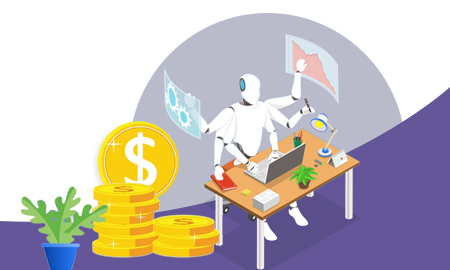Debt collection has always been challenging, often involving tedious processes and significant manual labor. Enter Robotic Process Automation (RPA)—a technological marvel reshaping the debt collection landscape by streamlining operations and minimizing human error. As the debt collection industry evolves, integrating RPA with advanced technologies like Artificial Intelligence (AI) and Machine Learning (ML) is a game-changer.
The Evolution of RPA in Debt Collection
RPA transforms debt collection by automating repetitive, time-consuming tasks such as invoice processing, data entry, and compliance reporting. These bots ensure an error-free debt collection process and optimize operations using accurate data. According to Grand View Research, the global RPA market was valued at USD 1.40 billion in 2019 and is expected to grow at a CAGR of 40.6% from 2020 to 2027.
Enhancing Customer Experience
Consumers today have high expectations for personalized services, fast processing times, and responsive support. RPA enhances customer experience from initial onboarding to collection by speeding up processes and facilitating timely and accurate communication. Bill Gates once said, “Automation applied to an inefficient operation will magnify the inefficiency.” Therefore, integrating RPA into an efficient process significantly enhances overall performance.
Boosting Operational Efficiency
Operational efficiency is critical in the highly competitive financial services industry. RPA helps drive down costs by automating transaction-heavy and manually intensive tasks. Digital workers can retrieve and compile data from multiple systems, reconcile amounts, and resolve discrepancies in real-time. As Peter Drucker noted, “Efficiency is doing things right; effectiveness is doing the right things.” RPA ensures both.
Driving Sustainable Growth
In an era of low interest rates and costly digital transformation initiatives, identifying new financial planning product opportunities is essential for increasing revenue. RPA helps financial institutions streamline operations, allowing them to focus on growth strategies. Integrating AI and ML with RPA can analyze data and predict outcomes, facilitating informed decision-making and driving sustainable growth.
Automated Report Generation
Many financial service providers are utilizing RPA to automate manual tasks involved in report generation. This process includes optimizing data extraction, standardizing data aggregation, and developing templates for reporting, reviewing, and reconciling reports. The immediate return on investment (ROI) realized through automation makes RPA an attractive solution for report generation.
Automated Mailing and Reminder Communication
RPA enables timely emails and reminder communications, facilitating a convenient and quick debt collection process. Bots navigate multiple systems, validate data, conduct rule-based background checks, and decide whether to approve or disapprove delay applications. This automation improves customer communication and enhances collection efficiency.
Regulatory Compliance
With increasing regulatory requirements, RPA strengthens the governance of financial processes. By consolidating data from various systems, RPA reduces manual business processes and ensures compliance with regulations. This is crucial in limiting the risks of regulatory fines and reputational damage.
Practical Examples of RPA Utilization in Debt Collection
| Process Area | Automation Strategies |
|---|---|
| Invoice Processing | RPA can automate the entire invoice processing workflow, from capturing invoice data to validating and posting invoices into the accounting system. This reduces manual errors and accelerates the invoicing process. |
| Data Entry | RPA bots can automatically enter data from multiple sources into a central database, ensuring data consistency and freeing up human agents for more complex tasks. |
| Compliance Reporting | RPA ensures timely and accurate compliance reporting by consolidating data from various systems, performing necessary calculations, and generating reports in the required formats. |
| Payment Reminders | Automated systems can send timely reminders to customers about upcoming or overdue payments, improving collection rates and reducing the need for manual follow-ups. |
| Customer Interaction | RPA can facilitate initial customer interactions by handling common queries through chatbots or automated phone systems, ensuring customers receive prompt responses while freeing human agents to handle more complex issues. |
Future Trends in RPA for Debt Collection
The future of debt collection lies in the seamless integration of RPA with advanced technologies like AI and ML. This combination enhances customer experience, improves operational efficiency, and ensures regulatory compliance. The focus will be on leveraging these technologies to drive sustainable growth and maintain a competitive edge.
Imperatives for CFOs
- Invest in Technology: Embrace RPA and other digital solutions to streamline RCM processes and reduce costs.
- Focus on Compliance: Implement robust compliance measures to protect patient data and enhance trust.
- Enhance Patient Engagement: Use technology to provide multiple payment options, clear communication, and proactive follow-ups.
Incorporating RPA into the debt collection process is more than just a trend; staying competitive in the evolving financial landscape is necessary. By leveraging RPA, debt collection agencies can streamline operations, reduce manual errors, and enhance customer satisfaction. As Eliyahu Goldratt said, “Automation is good, so long as you know exactly where to put the machine.” For the debt collection sector, the time and place for RPA are here and now.
For more insights on how RPA can transform your debt collection process, contact Fusion CX today.


